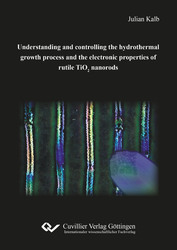| Departments | |
|---|---|
| Book Series (96) |
1377
|
| Nachhaltigkeit |
3
|
| Gesundheitswesen |
1
|
| Humanities |
2361
|
| Natural Sciences |
5405
|
| Mathematics | 229 |
| Informatics | 318 |
| Physics | 980 |
| Chemistry | 1363 |
| Geosciences | 131 |
| Human medicine | 243 |
| Stomatology | 10 |
| Veterinary medicine | 108 |
| Pharmacy | 147 |
| Biology | 835 |
| Biochemistry, molecular biology, gene technology | 121 |
| Biophysics | 25 |
| Domestic and nutritional science | 45 |
| Agricultural science | 1004 |
| Forest science | 201 |
| Horticultural science | 20 |
| Environmental research, ecology and landscape conservation | 148 |
| Engineering |
1789
|
| Common |
97
|
|
Leitlinien Unfallchirurgie
5. Auflage bestellen |
|
Advanced Search
Understanding and controlling the hydrothermal growth process and the electronic properties of rutile TiO2 nanorods (English shop)
Julian Kalb (Author)Preview
Table of Contents, PDF (570 KB)
Extract, PDF (600 KB)
As a nontoxic, chemically stable, and frequently occurring material with various valuable electronic and optoelectronic properties titanium dioxide (TiO2) has great potential for innumerable applications. The broad range of properties and applications can even be extended by using nanostructured TiO2. In addition, nanostructured TiO2 systems offer a high surface area, single crystal structures, and shape related scattering facilities. In spite of intensive research on this material in the past, many properties which are essential for various applications are not yet understood or even controllable. In this book, fundamental questions of the growth mechanism, the position-controlled fabrication, and the optical and electronic properties of rutile TiO2 nanorods are discussed.
At the beginning, the properties of TiO2 are listed in detail. Subsequently, the preparation of suitable seed layers for the hydrothermal growth of rutile TiO2 nanorods on various substrates is described in detail. A chapter dealing with the hydrothermal growth process itself explains the origin and importance of the fine structure in these rods. Furthermore, new low-cost and efficient lithography techniques such as a scanning probe and a laser-induced melting technique are introduced for the structured growth of these nanorods. The resulting superstructures are compared with those of conventional electron-beam lithography. In addition to a variety of possible applications of such structures, some aspects of their light scattering properties are discussed in this book. Finally, the electronic properties of these nanorods are presented and the influence of crystal defects on the bias and time-dependent transition current is described.
| ISBN-13 (Hard Copy) | 9783736971264 |
| ISBN-13 (eBook) | 9783736961265 |
| Final Book Format | A5 |
| Language | English |
| Page Number | 442 |
| Lamination of Cover | glossy |
| Edition | 1. |
| Publication Place | Göttingen |
| Place of Dissertation | Konstanz |
| Publication Date | 2019-12-03 |
| General Categorization | Dissertation |
| Departments |
Physics
Physics of condensed matter (including physics of solid bodies, optics) Chemistry Inorganic chemistry Geosciences Crystallography |
| Keywords | Nanotechnologie, Nanostruktur, Titandioxid, TiO2, Titanoxid, Lithographie, Hydrothermales Wachstum, Nanoelektronik, Anatas, Rutil, Nanodraht, Halbleiter, Metalloxid, Metalloxidhalbleiter, Metalloxidnanostrukturen, Halbleiternanostrukturen, Nanostrukturierung, Laserlithographie, hydrophile Oberflächen, Dünnschichten, Halbleiterdünnschichten, Nanolithographie, Rasterkraftlithographie, nanotechnology, nanostructure, titanium dioxide, titanium oxide, lithography, hydrothermal growth, nanoelectric, nanoelectronic, anatase, rutile, nanowire, nanorod, semiconductor, metal oxide, metal-oxide, metaloxide, metal oxide semiconductor, metal oxide nanostructure, semiconductor nanostructure, nanostructuring, nanofabrication, laser lithography, hydrophilic surfaces, thin films, semiconductor thin films, nanolithography, scanning probe lithography |
| URL to External Homepage | https://www.schmidt-mende.uni-konstanz.de/ |








